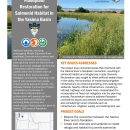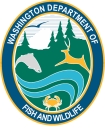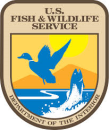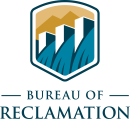Location



















States
WashingtonEcosystem
River/stream, WetlandIntroduction
Salmonid species are central to the economy and cultural identity of Washington and its sovereign Tribal nations, and the decline of salmonid species in the state is an ongoing concern. Historically, salmonids were abundant in south-central Washington’s Yakima River Basin (Harrison, n.d.). Today, salmon returns have declined and two salmonid species, Middle Columbia River (MCR) steelhead (Oncorhynchus mykiss) and bull trout (Salvelinus confluentus), have been listed as endangered under the Endangered Species Act. Their populations continue to be threatened by widespread habitat degradation and fish passage fish passage
Fish passage is the ability of fish or other aquatic species to move freely throughout their life to find food, reproduce, and complete their natural migration cycles. Millions of barriers to fish passage across the country are fragmenting habitat and leading to species declines. The U.S. Fish and Wildlife Service's National Fish Passage Program is working to reconnect watersheds to benefit both wildlife and people.
Learn more about fish passage barriers (Federal Caucus, 2021).
In 2002, University of Montana Flathead Lake Biological Station and Central Washington University researchers published a study on behalf of the U.S. Bureau of Reclamation (Reclamation) and the Yakama Nation that identified a reach of the Yakima River in Kittitas County as critical juvenile salmonid habitat. The 280-acre Schaake Property, with two miles of Yakima River frontage, fell within this reach. Prior to being purchased by Reclamation for restoration in 2003, the property was used for cattle, feedlot, and packing-house operations. Levees constructed on the property in 1930 for flood control inhibited connectivity between the river and floodplain, resulting in a loss of critical side channels and large woody debris that provide refuge during floods and rearing habitat for juvenile salmonids.
Reclamation developed the Schaake Habitat Improvement Project, in collaboration with several partners, to restore approximately 130 acres of floodplain within the Schaake property for salmonid habitat. Reclamation undertook this project as part of their mission outlined in the Yakima River Basin Water Enhancement Project (YRBWEP) to protect fish and wildlife through improved water management. This was accomplished by removing almost a one-mile portion of the Schaake levee, constructing an inland flood protection berm, creating perennial side channels, and initiating revegetation.
Key Issues Addressed
Side channels are essential rearing habitat for juvenile salmonids. They are important feeding areas and also have lower temperatures and water flows than mainstem river channels, providing refuge on warm days and during floods. Acceleration of water around deposited woody material also scours deep pools into the channel bed, increasing habitat complexity. Levees inhibited regular interaction between the river and the floodplain, which led to a loss of side channels. Additionally, while naturally there would be major runoff in the spring that tapers off into the summer, Reclamation releases large quantities of water in the summer during peak river use for irrigation. This coincides with the return of adult salmonids migrating upstream to spawn. The lack of side channels means fish migrating upstream do not have anywhere to escape these high-velocity flows.
Reclamation also sought to create new wetlands and enhance existing wetland areas within the Schaake property to offset the habitat loss of artificial wetlands within Kittitas valley. As part of YRBWEP, irrigation districts are encouraged to conserve water by decreasing the permeability of leaky canals. Sealing the canals caused the artificial wetlands created by the canals’ leakage to dry up. Creation of side channels would increase inundation frequency and facilitate formation of natural riverine wetlands, as well as enhance depressional wetlands.
Reclamation incorporated flood risk mitigation for the nearby city of Ellensburg into the planning process. The Schaake property is in close proximity to critical infrastructure, including a railroad, highway, and power lines. The planning process included modeling of potential flood risks caused by levee removal to inform development of the most appropriate plan that would maximize the project area while not putting people and structures at risk. Stakeholder concerns about access to water for irrigation and fishing also needed to be considered.
Project Goals
- Restore the connection between the Yakima River and its floodplain
- Create side channels and wetlands to increase create refugia and habitat for juvenile salmonids
- Promote natural hydrological processes while limiting flood risk to protect infrastructure in the surrounding area
Project Highlights
Habitat for All: Increased habitat complexity and availability of breeding areas provided by LWM installation, native species seeding, and more frequent floodplain inundation benefit other native species like elk.
- Flood Protection: The project team modeled the maximum amount of floodplain that could be reconnected without increasing flood risk to nearby critical infrastructure. The team determined which parts of the Schaake levee needed to remain in place. Reclamation engineers achieved further flood protection by designing a three-foot-high and approximately 0.7-mile-long berm using the material excavated from onsite floodplain contouring, levee removal, and side channel excavation.
- Habitat Creation: Engineers recontoured the floodplain to create 1.8 miles of perennial side channels that would re-establish hydraulic connectivity and reinvigorate existing side channels. Construction crews excavated existing depressions to increase flow to one mile of existing side channels that were seasonally connected. Juvenile salmonids now have refuge where they can escape heavy water flow.
- Installation of Large Woody Material: Large woody material (LWM) was useful in both flood protection and habitat creation. Construction crews installed log structures in the floodplain at key locations to increase stability during flooding. They also placed LWM and small woody material in select areas along the mainstem, in constructed side channels, and in wetlands to improve hydraulic function and create habitat and cover for fish, including juvenile salmonids. Willow plantings along the banks will eventually anchor the LWM structures and contribute organic material to the side channels and mainstem.
- Floodplain and Wetland Restoration: The removal of much of the Schaake levee resulted in approximately 130 acres of natural floodplain reconnected to the Yakima River. Floodplain contouring also created side channels that connected wetlands to increase inundation frequency. This reconnection and floodplain contouring increased not only wetland function, but also attenuation of flood flows, access to high-flow refugia for salmonids, and enhanced riparian riparian
Definition of riparian habitat or riparian areas.
Learn more about riparian habitat.
Lessons Learned
Legislative authority to purchase land for improving water management and habitat in the Yakima basin meant Reclamation was already looking for opportunities to improve critical areas in the basin such as the Schaake property. The large size of the property and the proximity to the river enabled Reclamation to implement one of the largest floodplain restoration projects in the Yakima basin.
The Schaake project team found that several of their strategies promoted the project’s success. The design team made use of the natural features of the land by using existing low points and wetlands and creating channels that connected them. Reclamation also increased the project’s efficiency by using in-house expertise. This increased project design flexibility and created opportunities for more-efficient communication between the design team and the construction crew. The team designed 60% of the restoration plan, began construction, and adjusted the plans accordingly when necessary.
External and internal collaboration were central to the project’s success. Due to the proximity of the project site to Ellensburg, many stakeholders were heavily involved in this project. Prior to the development of the project plan, there were concerns over land use and competing demands for water in the area. Stakeholders’ feedback allowed the design team to reach mutually-beneficial compromises.
In addition to collaboration with external stakeholders, the project also had an interdisciplinary team that added a holistic perspective. The variety of knowledge and experiences brought to each phase of the process – project design, implementation, restoration, and adaptive management – made for a more integrated and comprehensive planning process.
Multiple government agencies own land along the river with the intention of implementing restoration projects. Reclamation’s work on the Schaake property has provided groundwork for how to conduct successful restoration in this area that these agencies can draw from. Completion of similar floodplain restoration projects will ultimately result in one large integrated area of restored floodplain.
Next Steps
- Collaborate with the U.S. Fish and Wildlife Service to perform electrofishing surveys in the created side channels to assess which fish species are present and quantify project success
- Continue revegetation efforts to establish an understory of native grasses that outcompete non-native vegetation and then install an overstory of trees, shrubs, and herbaceous species where appropriate
- Fulfill the monitoring obligation that Reclamation is under by conducting long-term vegetation monitoring for the next 10 years
- Explore how to implement recreational and public-use opportunities on the property
Funding Partners
Resources
- Bureau of Reclamation (2019, May). Schaake Property Habitat Improvement Project: Finding of No Significant Impact and Environmental Assessment (PN19-5). US Department of the Interior.
- Federal Caucus. (2021, February). Middle Columbia River Steelhead: Progress toward Recovery.
- Harrison, John. (n.d.) Yakima River. Northwest Power and Conservation Council.
- Stanford, J. A., Snyder, E. B., Lorang, M. N., Whited, D. C., Matson, P. L., & Chaffin, J. L. (2002). The Reaches Project: Ecological and geomorphic studies supporting normative flows in the Yakima River Basin, Washington. Open File Report, 170-02.
- Columbia-Cascades Area Office of the Bureau of Reclamation
Contact
Janine Empel, Bureau of Reclamation: jempel@usbr.gov
CART Study Authors
- Kate Richter, Student Intern, University of Arizona
- Janine Empel, Bureau of Reclamation: jempel@usbr.gov
Suggested Citation
Richter, K., D. and Empel, J., M. (2023). “Floodplain Restoration for Salmonid Habitat in the Yakima Basin.” CARTCCAST. Retrieved from https://www.fws.gov/project/floodplain-restoration-salmonid-habitat.










